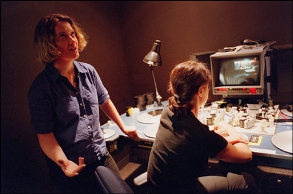Opening at the Harvard University Art Museums this month is Girls on Film, an installation by artists Julie Buck and Karin Segal of 70 photographs depicting female film-studio workers who posed for what are known as color-timing control strips. Buck and Segal retrieved these beguiling images from discarded film leaders-usually blank film attached to the ends of a print to protect it from damage when it is threaded through a projector. They created the photographic prints in the installation by restoring, editing, and enlarging selected frames.
On view through September 18, 2005, at Harvard’s Sert Gallery in the Carpenter Center for the Visual Arts, Girls on Film presents the artists’ interpretation of this provocative imagery in a panoramic display that forms a continuous work of art. A tension develops between the found images and the formal and material effects the artists achieve with their edited and enlarged prints.
The installation foregrounds a technical process in film that is normally hidden from public view. “Through their compelling retrieval of these formerly discarded and anonymous images, Julie Buck and Karin Segal offer insight into a little-known aspect of film production,” said Thomas W. Lentz, Elizabeth and John Moors Cabot Director of the Harvard University Art Museums. “In the process, they introduce a type of image that should offer a new point of entry into discussions of both the cinema and its representations of women.”
 Color timing is a fundamental tool the film industry used from the 1920s to the 1990s to establish visual continuity between shots that may have been filmed over several months, under different lighting conditions, and even on different film stocks. Color-timing strips-or “China Girls,” as they came to be known-were film frames of variously posed women that technicians in the processing lab used to achieve consistent color balance and tonal density throughout a film. Women’s skin was thought to offer a particularly nuanced tonal gauge. Some of the women posing for these shots were lab secretaries or technicians; others were models or actresses hired for the job.
Color timing is a fundamental tool the film industry used from the 1920s to the 1990s to establish visual continuity between shots that may have been filmed over several months, under different lighting conditions, and even on different film stocks. Color-timing strips-or “China Girls,” as they came to be known-were film frames of variously posed women that technicians in the processing lab used to achieve consistent color balance and tonal density throughout a film. Women’s skin was thought to offer a particularly nuanced tonal gauge. Some of the women posing for these shots were lab secretaries or technicians; others were models or actresses hired for the job.
Although these shots had a utilitarian purpose, the way the women were posed, lit, and filmed often mimicked the representational codes of commercial cinema. As the artists note, “If it were just about a [color] standard, no more than 20 prototypes would have been necessary. Obviously, the format offered an opportunity to play out poses that were a lot more than functional.” Perhaps as a result, these color-timing control strips took on a life of their own, sometimes reappearing as “pin-ups” in projection booths, for example. According to a lab technician familiar with the genre, says Buck, some of the most appealing of these strips were reproduced more than even the most successful Hollywood films.
Both artists conceive of their practice as rescuing these women from the margins of cinema, recasting them as movie stars in their own right. It was the creative exploitation of the format and the obsolescence of the functional device, however, that initially attracted Buck and Segal to these images. “As with so many processes, color timing is now accomplished digitally,” said Segal. “It is ironic, therefore, that the very digital technology that allowed us to recover and rework these images-elevating them to the status of icons or portraits-has also made them all but disappear from the film industry.”
About the Artists
Julie Buck and Karin Segal have worked in the film and art fields for the last 10 years. Girls on Film, their latest project, premiered at the Courthouse Gallery at the Anthology Film Archive in New York City in February 2005 before traveling to Harvard. Both Julie and Karin have supported the Chlotrudis Society in a variety of ways. We offer congratulations to them both!
JULIE BUCK, born in 1974 in Walnut Creek, California, is the head of conservation at the Harvard Film Archive. She has a degree in film history from Brigham Young University and a certificate in film preservation from George Eastman House. Buck has taught film at several Boston institutions and has curated film series throughout the Northeast. Buck is also a collage artist. She currently resides in Cambridge, Massachusetts.
KARIN RYWKIND SEGAL, born in 1973 in Tel Aviv, holds a degree in fine arts from the Bezalel Academy of Art and Design in Jerusalem and has exhibited her art in Boston, Jerusalem, and Tel Aviv while curating film and video series in Boston. She is the assistant conservator and publicist at the Harvard Film Archive and resides in Boston.
